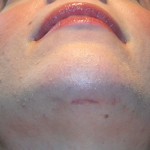Chin augmentation is usually done with an implant. By putting a synthetic implant in front of and around the sides of the chin, the soft tissue of the chin is pushed forward creating increased horizontal projection. As the soft tissue of the chin follows the underlying bone in a virtual 1:1 relationship, chin augmentation is the single most predictable implant procedure in the body.
The most common approach in which to place a chin implant is through a skin incision under the chin. (submental approach) While a skin incision can be completely avoided through an incision in the mouth, this approach causes more postoperative discomfort (as more muscle is cut through) and offers no significant advantage. The submental approach places a small skin incision in the easily identifiable skin crease between the chin pad and the beginning of the neck skin.
This submental skin incision can be of variable lengths. The controlling factor is what type of chin implant is being used as it must be able to be passed through it. Most chin implants used are made of silastic or silicone rubber. This material is quite flexible and this can be used as an advantage to make they incision smaller. Some type of chin implants (Medpor) are stiffer and more rigid and a much longer incision is needed.

The submental skin incision is a very discreet approach for chin augmentation. While a longer incision (2.5 to 3 cms.) is well hidden and very acceptable, the minimal incision approach strives to make it even smaller. This can be consistently done when the implant is made of a flexible silicone rubber material.
Dr. Barry Eppley
Indianapolis, Indiana


